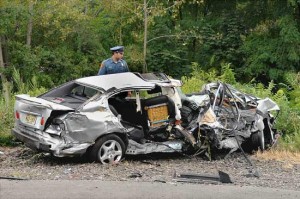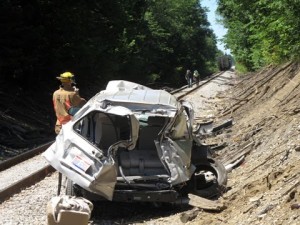The Train Always Wins — Always!
In order to stay up-to-speed on transportation and, more specifically, rail issues, I use Google Alert which collects and sends me emails several times a day with links to news items involving Amtrak or train travel. And almost every day, day after day, there is a story about an Amtrak train striking a car or truck at a grade crossing or hitting a pedestrian walking along a track somewhere. Freight trains are also involved, but not as often since they typically are traveling at slower speeds.
 About 500 people are killed by trains every year. And here’s the thing: every single one of those deaths is avoidable. Not one of those deaths is the fault of Amtrak or whichever one of the freight railroads might have been involved (this ridiculous judgment notwithstanding).
About 500 people are killed by trains every year. And here’s the thing: every single one of those deaths is avoidable. Not one of those deaths is the fault of Amtrak or whichever one of the freight railroads might have been involved (this ridiculous judgment notwithstanding).
People insist on being careless or reckless or inattentive … and they get killed or, if they’re very, very lucky – just badly injured. They drive around the crossing gates … or the car in front of them stops, leaving them sitting on the track … or they’re speeding at night and can’t stop in time to avoid running smack into the side of a moving train. Young people are hit and killed while walking on the tracks; they’re usually listening to loud music through ear buds and can’t hear the engineer frantically blowing his horn as the train comes up from behind them. And, sadly, it’s quite true that many of the so-called pedestrian accidents are, in fact, suicides.
 I feel real sympathy for the engineers, who are the forgotten victims in these incidents. With the speed and weight and momentum of their trains, there is no possible way they can stop in time to avoid hitting a car trying to beat them across the crossing. They do try, of course. Some are able to deal with these gruesome events better than others, but they all pay an emotional price.
I feel real sympathy for the engineers, who are the forgotten victims in these incidents. With the speed and weight and momentum of their trains, there is no possible way they can stop in time to avoid hitting a car trying to beat them across the crossing. They do try, of course. Some are able to deal with these gruesome events better than others, but they all pay an emotional price.
 OK, so what’s the answer? Well, many years ago, the railroads formed Operation Lifesaver in an effort to promote more awareness. And railroads have added warning lights and gates at more crossings. It’s helped, too. Statistically, the number of accidents has just about been cut in half over the years.
OK, so what’s the answer? Well, many years ago, the railroads formed Operation Lifesaver in an effort to promote more awareness. And railroads have added warning lights and gates at more crossings. It’s helped, too. Statistically, the number of accidents has just about been cut in half over the years.
But 500 people a year are still dying. It’s an awfully high price to pay for carelessness.



